Design and Ergonomics
Samsung's trademark skinniness is here; the tablet is only 0.5" thick. The back panel is aluminum and the quality and look are more appealing than the Asus Eee Slate's white textured plastic back. There are plenty of vent holes on the back and a very basic selection of ports. The tablet has just 1 USB 2.0 port, micro HDMI, a microSD card slot, and a combo mic/headphone 3.5mm jack. Controls are minimal with only volume controls, a power button and an orientation lock button.
The Samsung Series 7 Slate runs relatively quiet and cool. In the first day we heard the fan more often because Windows was indexing files and installing updates, but after that, the fan was either inaudible or fairly quiet when it did kick in. If you play Left 4 Dead 2 or stream an hour long Flash video, you'll hear it kick up, but it's fairly quiet when doing web, MS Office and Photoshop work.
Some Slate bundles include a surprisingly small dock with a pop-up stand that supports the tablet at a useful but unadjustable angle. It's a sturdy piece that's made of metal and it has Ethernet, 3.5mm stereo, one USB port and a full size HDMI port at the rear. If purchased separately, the dock sells for $99. Some bundles include a sharp looking Samsung Bluetooth keyboard that sells separately for $79.99, though any Bluetooth or USB keyboard will work with this Windows 7 machine. The Samsung keyboard uses two AAA batteries, and is light but sturdy. It's attractive and the chicklet keys have good tactile feedback though travel is low like a laptop's. The "03" version (the model number has -03 at the end) comes with the dock and keyboard and lists for $1,299 to $1,349. If you buy just the tablet it sells for around $1,000.
The first batch of Series 7 Slates were plagued with a quality issue where the UV adhesive used to glue the glass to the casing wasn't fully cured. If you're an early adopter and have a display that's lifting and/or showing light in the corners when viewing dark backgrounds, send it back for a replacement. Our first unit, purchased retail, came with 1 corner of the display lifted, and light distortion at two corners. Our second, purchased two months later has no problems.
Display and Digitizer
The Wacom dual digitizer supports multi-touch and pen input via the included EMR pen. This is a precise active digitizer, and not a capacitive stylus experience. It's perfect for handwriting using One Note or forms, and it supports 1,024 levels of pressure sensitivity for Windows integrated applications like Journal, as well as Microsoft Office and apps like Art Rage that use the WinTab driver. Photoshop uses different pen drivers, and Samsung offers two Wacom drivers to get pressure sensitivity in Adobe and WinTab apps. You can download these from Samsung's website, but they don't show up in Samsung's software update manager for some reason. It's often hard to get pressure sensitivity working in both Adobe and WinTab apps, so we're thoroughly pleased with the Series 7 Slate, even if the drivers aren't pre-loaded. Our only complaints? There's no silo or tether cord for the pen (the tablet is too thin and compact for a silo), and the very wide screen could be awkward for digital painting and art (it's better for movie watching).
With our first unit, the display had very vibrant colors but viewing angles weren't as wide as the Asus Eee Slate. Our second unit with a fully adhered display had noticably better brightness and viewing angles. So if you buy one now, you should get a very impressive display in terms of sharpness, brightness, color saturation and accuracy: it's simply gorgeous. The Samsung's colors are accurate, but the color saturation makes photos and digital art look better than on other monitors; keep that in mind when doing digital art or photograph processing for commercial purposes.
Samsung claims a very respectable 400 nits for brightness. The display is very glossy (sure to drive artists crazy, but it's hard to find a matte display slate design tablet). Despite the high brightness, the tablet is a bit hard to see outdoors due to glare.
The tablet has Intel Advanced-N dual band WiFi 802.11b/g/n and Intel HD 3000 integrated graphics and thus supports WiDi (wireless display). Rather than using a micro HDMI cable to stream audio and video to an HD TV or AV receiver with HDMI port, you can use a WiDi receiver ($100) like the NetGear Push2TV HD plugged into your home AV gear and stream up to 1080p video with 5.1 sound. If you're an artist you can demo drawing technique using a big screen, or give presentations wirelessly too. Very cool! WiDi software is pre-loaded but ours complained about missing DLL files, so we manually updated our Intel graphics driver and WiDi software from Samsung's support site and got it working perfectly.
Battery Life
Refreshing: a Windows slate running on a "real" CPU (not an Intel ATOM) that has good battery life. The tablets runs 4.5-5.5 hours on a charge with WiFi and Bluetooth on, brightness set to 50% and a few heavy apps like Photoshop running. If you just use MS Office, turn down brightness and use WiFi only when needed, you just might reach Samsung's claimed 7 hour runtimes, but that's pushing it. The 5520 mAh Lithium Ion battery is sealed inside, unlike most laptops. That means you can't swap in a spare when on the go.
Conclusion
The Samsung Series 7 Slate is definitely the best slate form factor Windows 7 tablets to hit the market, and it's earned our Editor's Choice award. It packs plenty of power thanks to the Intel Core i5 CPU and Intel HD 3000 graphics that trounce Atom-based tablets from HP, Acer and Fujitsu. The display is superb though glossy and colors are almost better than life. The touch experience is the best we've experienced from a Windows 7 tablet, and we weren't stymied when accessing menus and smaller control elements like the "x" close box at the upper corner of windows. Samsung's launcher makes the tablet friendly for those who are used to iOS and Android tablets. The Series 7 Slate is Windows 8 ready (we've updated ours and Samsung offers updated Windows 8 drivers and apps for download) since Microsoft supplied this tablet to Windows 8 developers in mid-2011. If you need a Windows tablet, we can easily recommend the Samsung Series 7 Slate. That said, the new crop of Windows 8 tablets in some cases offer even better battery life and faster performance thanks to third generation Intel Ivy Brige vs. Sandy Bridge in the S7S.
List Price: $1,099 to $1,499 (64 vs. 128 gig SSD, Windows 7 Home 7 vs. Pro, bundles with the dock and Bluetooth keyboard vary with price)
Web Site: www.samsung.com
|




|

